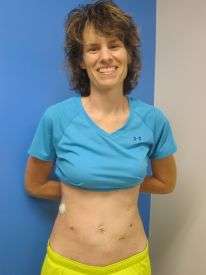UA surgeons first to remove whole pancreas combined with auto-islet transplant

(Medical Xpress)—University of Arizona surgeons at The University of Arizona Medical Center have performed the world's first fully robotic total pancreatectomy with a successful simultaneous autologous islet transplant on a woman suffering from chronic pancreatitis.
The minimally invasive surgery was performed on Tami Alveshere, a 39-year-old woman from North Dakota. Leading the surgical team from the UA department of surgery were Dr. Rainer W.G. Gruessner, professor and chairman, and Dr. Carlos Galvani, associate professor and director of minimally invasive and robotic surgery. Dr. Horacio Rilo, professor and director of the Institute for Cellular Transplantation, isolated 248,000 islets from the removed pancreas using the department's Class 10,000 clean room, a state-of-the art laboratory designed for this procedure.
Galvani was part of the team at the University of Illinois, Chicago, or UIC, that performed the first-ever robotic partial pancreatectomy with combined auto-islet transplant in 2007. During the procedure at UIC, only about 60 percent of the patient's pancreas was removed.
"Robotically removing the whole pancreas is more complex than removing part of the organ because the gland is in close proximity with the digestive tract, biliary tract and major arteries and veins such as aorta, inferior vena cava and portal vein," explained Galvani.
"Other attempts to perform this procedure robotically have been made, but were incomplete," said Gruessner. "We are the first to successfully perform all three stages of the procedure robotically: removing the entire pancreas, reconstructing the gastrointestinal tract and transplanting the islets."
Chronic pancreatitis is a disease that progressively destroys pancreatic tissue, causing pain that frequently requires hospitalization and severely compromises quality of life. Medical management, consisting of analgesics and pancreatic enzyme replacement, rarely leads to acceptable relief of the pain. In Western Europe and North America, chronic pancreatitis is diagnosed in about five people in every 100,000 each year.
Alveshere had suffered from debilitating chronic pancreatitis for years and required high doses of narcotic pain medication. A pancreatectomy was her last option to escape the severe pain caused by the disease and the dependency on narcotics.
A pancreatectomy, the surgical removal of a person's pancreas, relieves the pain. However, without a pancreas, the person will develop brittle diabetes because islets in the pancreas make insulin, which controls blood sugar (glucose).
"Other attempts to perform this procedure robotically have been made, but were incomplete," said Gruessner. "We are the first to successfully perform all three stages of the procedure robotically: removing the entire pancreas, reconstructing the gastrointestinal tract and transplanting the islets."
Surgeons at the UA have performed nearly 40 open pancreatectomies with islet auto-transplant, or TP-IAT, to treat severe chronic pancreatitis for the past three years. During this procedure, islets are isolated from the removed pancreas in the department's laboratory and then the islets are injected into the liver where they continue to produce insulin and prevent the development of brittle diabetes. By using the patient's own islets, there is no risk of rejection.
"As one of the nation's busiest islet transplant centers, we attract patients from all over the country," said Rilo. "Less than a handful of centers have the technology to perform successful islet transplants."
The open procedure requires a large incision and a longer recovery. Using the da Vinci surgical robot with its 3-D visualization and precise movement capabilities, surgeons are able to carefully remove the pancreas without damaging the islets with only three small incisions in the abdomen to insert the laparoscopic instruments, plus a fourth small incision a couple of inches in the bikini region to remove the organ. Small incisions allow for a shorter hospital stay and fewer complications.
Alveshere was discharged from the hospital 10 days after her July 5 surgery, is off insulin and has dramatically reduced her pain medications.
Said Gruessner: "Our surgeons are pioneers in both pancreatic and robot-assisted surgeries. By integrating our expertise with new technology, we are able to offer new, innovative minimally invasive options for our patients so their surgery is less traumatic and they are able to heal faster."










.jpg)





